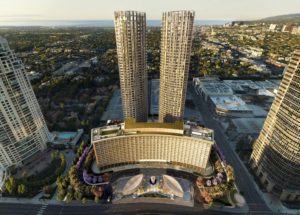LOS ANGELES — The Millennium Biltmore Hotel Los Angeles will celebrate her centennial in 2023 with restored ballroom frescoes and windows, and a year’s worth of special events.
“I want to acknowledge everyone who loves this building,” said Los Angeles Conservancy President and CEO, Linda Dishman at a Dec. 2 event. “The Biltmore is here because people had a vision of building a great hotel to serve Los Angeles. The Biltmore is here because owners through the years understood the value of the architecture and restored it. The Biltmore is here because it is the place where people have a personal connection, the place is part of their history.”
The hotel is among the great hotels of Los Angeles, and made a name not only for hosting the Academy Awards, but serving as the site of the organization’s founding, in the Crystal Ballroom in May 1927. Dozens of movies and TV shows have been filmed at the hotel. Hundreds of historic events have occurred at the hotel, including serving as the site of the 1960 Democratic Convention, which nominated John F. Kennedy.
Los Angeles Destination Hotel
The hotel was the creation of entrepreneur John McEntee Bowman, in a design by Schultze & Weaver, architects of New York’s Waldorf-Astoria, Park Lane, Sherry-Netherland and the Pierre. The Italian artist Giovanni Battista Smeraldi created the interior murals, much of them conserved by theater artist Anthony Heinsbergen. Beyond California, Smeraldi’s work is also at the New York Biltmore, the Atlanta Biltmore, The Breakers in Palm Beach and Chateau Frontenac in Quebec City.
The legend of the hotel was that the Oscar statuette design was created on a hotel napkin.
“The 1923 opening of The Biltmore is widely credited for putting Los Angeles on the map as a coveted metropolitan destination. Among its many accolades, the hotel hosted the Academy Awards throughout the thirties, was the stage where John F. Kennedy announced his presidential candidacy, operated a covert speakeasy during Prohibition and served as the backdrop for some of the most acclaimed films in cinematic history,” said Alex Decarvalho, the hotel’s general manager, in a release.
“We welcome locals and visitors alike to celebrate with us – and rally around a momentous year for a seminal symbol of Los Angeles heritage,” said Decarvalho, who arrived in August to lead the hotel.
Celebrates California’s Hispanic History
The Public Art in L.A. website calls the 1500-room design hotel a “rationally constructed ordering of physical reality.” that was designed “in harmony with the Classic ideals and precedent.”
The hotel is not only a place to stay, but a tour in itself. For instance, the hotel includes the royal hall, a reproduction of the room where Queen Isabella first learned of America from Christopher Columbus. The room as an illuminated globe designed after one by Leonardo da Vinci, showing the geography of the world then known. Owing to the Latin heritage of California, the design includes Spanish history and explorers Cortez, Balboa, and Columbus.
Spanish-Italian Renaissance architecture is faithfully shown by the Olive Street facade opposite Pershing Square, where the imposing main entrance is located, and the Grand Avenue facade, opposite to which is Library Park. The building is in reddish, ornamental brick relieved by extensive use of cream-colored stone, antiqued copper on the cornice and terra cotta roof tiles. The Olive Street elevation suggests three massive towers separated by the courts.
Publicartinla.com
Architects Gene Summers and Phyllis Lambert stepped in to save the hotel in 1976 during the Bicentennial year, when a movement for the preservation of American history exploded. They paid only $5.4 million for the hotel, raising $30 million to modernize the building, including adding new restaurants.
Summers had worked for architect Ludwig Mies van der Rohe. He and business partner Phyllis Lambert were planning on a new L.A. hotel when the Biltmore came up for sale in 1976.
Gilded Age for Hotels
The hotel’s design is typical of the 1920s, when the U.S. economy boomed after World War I., and railroads expanded both business and personal travel. At the time, the hotel was not only a place to visit, but one of many centers of a hotel culture, where visitors stayed and ate in formal meals and rituals. While the hotel has a neo-classical look which was typical of the period, the design is also in the era’s typical H pattern, which allowed for the rooms in urban hotels to have fresh air, and access to light. In this period, even smaller cities had signature hotels.
The hotel is part of the worldwide Millennium & Copthorne Hotels group, founded in 1989 by Chairman, Mr Kwek Leng Beng, of Hong Leong Group and Singapore-listed real estate company City Developments.








